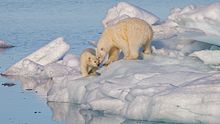User:Coolcat0827/sandbox
Maternity Den[edit]
A Maternity Den is a phenomenon observed in nature amongst certain mammals where a mother creates and resides within a subterranean lair to protect and care for their young. These dens are dug in snow or dirt and can also be in naturally forming caves and rock formations. They consist of one or more entrance holes, in some cases up to 150, and a main chamber. Some species use these dens as a perennial home while others only make use of them until their offspring matures.
Examples[edit]
Polar Bear[edit]

The Polar Bear (Ursus Maritimus) Creates their Den's commonly in deep snow drifts or at the foot of icebergs. The mother makes this den to provide a relatively warm and stable environment for her cub's survival. A suitable terrain for these polar bear mothers to dig these dens is most commonly found on snow drifts where the snow is deeper than average. These drifts are usually situated along costal river banks and through observations (Benson 1982) in the Beaufort Sea around 50% of pregnant Polar bears come to these river banks to make their dens[1]. After the dens completion the female polar bear will give birth and hibernate with her cubs in this den until the end of winter when the temperature is suitable for her cub to leave. Sometimes the mother will leave her den prematurely due to human activity in the arctic such as oil drilling. This usually results in the death of her cubs and cause the mother to start the cycle over again.
Arctic Fox[edit]

The Arctic Fox (Vulpes Lagopus) makes its den at higher altitudes to keep its distance from human activity as well as the Red Foxes (Vulpes Vulpes) that are attracted by it[2]. When a female Arctic Fox is pregnant they most commonly make their den in heavy pack ice and less often on land. These dens are made around November and their cubs are born in December and the mother nurtures them until they are ready to leave the den in late March or early April.
African Wild Dogs[edit]

The African Wild Dog (Lycaon Pictus) prefers to make it's den in rugged terrain where they are least likely to encounter their primary predator which are Lions (Panthera Leo). The dog's young suffer a particularly high mortality rate from Lions thus necessitating hiding their young in dens[3]. These dens are made in locations where Lions show up the least frequently and are also protected by male dogs. These den's are unique due to African Wild Dogs being a highly social species compared to other carnivore mammals because the males also participate in digging and protecting them not just the females.
References[edit]
1.Durner, George M, et al. “Polar Bear Maternal Den Habitat in the Arctic National Wildlife Refuge, Alaska.” Gale in Context, Arctic Institute of North America of the University of Calgary, Mar. 2006, https://go-gale-com.eznvcc.vccs.edu[1]
2.Sillero-Zubiri, C., Hoffmann M. and Whyte Macdonald, D. (2004). Canids: Foxes, Wolves, Jackals, and Dogs: Status Survey and Conservation Action Plan. IUCN/SSC Canid Specialist Group. p. 430. ISBN 2-8317-0786-2.
3.Selas, Vidar. “Arctic Fox Vulpes Lagopus Den Use in Relation to Altitude and Human Infrastructure.” Wildlife Biology, vol. 16, no. 1, Mar. 2010. Gale in Context, https://doi.org/ http://dx.doi.org.eznvcc.vccs.edu/10.2981/09-023. Accessed 23 Apr. 2023.[2]
4.Jackson, Craig R. “Heading for the Hills: Risk Avoidance Drives Den Site Selection in African Wild Dogs.” PLoS ONE, vol. 9, no. 6, 11 June 2014. Gale in Context, https://doi.org/http://dx.doi.org.eznvcc.vccs.edu/10.1371/journal.pone.0099686. Accessed 23 Apr. 2023.[3]
- ^ a b Durner, George (mar. 2006). "Polar bear maternal den habitat in the Arctic National Wildlife Refuge, Alaska". Arctic Institute of North America of the University of Calgary. Retrieved 4/23/2023.
{{cite news}}: Check date values in:|access-date=and|date=(help) - ^ a b Selas, Vidar (Mar. 2010). "Arctic fox Vulpes lagopus den use in relation to altitude and human infrastructure". John Wiley & Sons, Inc. Retrieved 04/23/2023.
{{cite news}}: Check date values in:|access-date=and|date=(help) - ^ a b Jackson, Craig (June 11 2014). "Heading for the Hills: Risk Avoidance Drives Den Site Selection in African Wild Dogs". Public Library of Science. 9 (6) – via Gale in Context Science.
{{cite journal}}: Check date values in:|date=(help)

